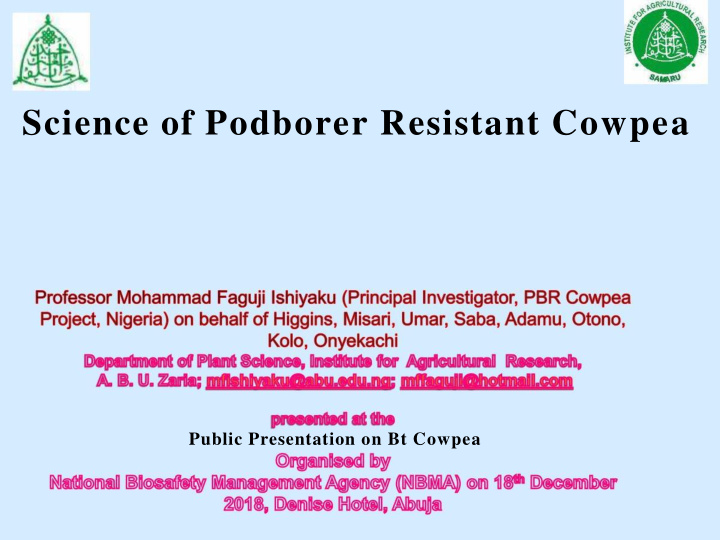



Science of Podborer Resistant Cowpea Public Presentation on Bt Cowpea
Naman Talaka!
Nigeria-Largest Producer and consumer global National cowpea demand deficit for Nigeria- >500,000 t National productivity average around 350Kg/ha grains Cultivated in cereal-based system Grown everywhere mostly in savannas Mode of utilisation-traditional, low level industrial
FOODS Dr M F Ishiyaku
Sucking bug complex ▪ Acanthomia spp ▪ Anoplocnemis curvipes ▪ Riptortus dentipes ▪ Nezara viridula
Maruca Moth Maruca larva
FEEDS ON YOUNG LEAVES FEEDS ON FLOWER BUDS FEEDS ON FLOWERS FEEDS ON YOUNG PODS BY BURROWING INTO PODS WITH HEAVY MARUCA INFESTATION SUCKING BUGS & STORAGE WEEVILS WILL HAVE NOTHING! MARUCA CAUSES UPTO 80% YIELD LOSS
SURMOUNTING CONSTRAINTS
1. INSECTICIDE SPRAYS EXPENSIVE *UNAFFORDABLE TO RESOURCE POOR FARMERS *USES UP PRECIOUS FOREIGN RESERVE UNSAFE TO HEALTH *CAUSES DEATH, SICKNESS, DISABILITY etc UNSAFE TO ENVIRONMENT *KILLS BENEFICIAL ORGANISMS, RESIDUAL
SAMPEA 7- High yielding semi-erect, brown SAMPEA 8-Insect Tolerant, early SAMPEA 9-Medium Maturing-Savannah SAMPEA 10-Striga and Alectra Resistant SAMPEA 11-Good for Dry season, nematode resistant etc SAMPEA 18
Screened 15,000 accessions, no resistance Resistance in Vigna vexillata (wild relative) Unsuccessful wide crossing e.g. Fatokun et al History of safe use GMOs since 1992-maize, cotton, rice, garden eggs etc The Bt Gene originate from a saprophytic and ubiquitous soil borne bacteria Gene product (the Cry protein) has long history of safe use by farmers as sprays since ancient times
Transformed with CryA1b gene from Bacillus thurengensis Gene construct pBSF16, Selectable (bar) reporter (uidA) genes for Phosphinothricin acetyl Transfarase (PAT) and Glucuronidase (GUS) Agrobacterium tumefaciens strain AGL1
A B C D E F G H I
Transgenic Plants infested with larva All larvae that fed on Transgenic plants (those with Bt genes in them) died.
W h y ? ▪ Confirm lab observation under field conditions ▪ Efficacy of gene under natural environment of production ▪ Expression level ▪ Interaction of genotype by environment if any Dr M F Ishiyaku
Application for CFT to National Biosafety Committee ▪ GENETIC CONFINEMENT ▪ MATERIAL CONFINEMENT ▪ GENE EFFICACY Dr M F Ishiyaku
Interaction with NBC to scrutinize application Verify measures put in place Dr M F Ishiyaku
CFT APPROVAL PROCESS:INTERACTION WITH REGULATORS Dr M F Ishiyaku
PERMIT FOR CFT GRANTED BY THE BIOSAFETY OFFICE- MARCH 5, 2009 Dr M F Ishiyaku
Moving from Laboratory to Field Dr M F Ishiyaku
Planting CFT
At bud initiation each test plant in all plots was infested with 40 1st instar larvae every 3 days until maturity This artificial insect pressure is more than thrice one can find in nature Planting of transgenic events Dr M F Ishiyaku
IT86D-1010 Non GM 709 GM parent 710 GM Non GM Check Dr M F Ishiyaku
Netting was introduced to ensure that infested larvae cause maximum damage possible
IT86D-1010 709A-IMPROVED 1023J-IMPROVED UNIMPROVED
Data collection ▪ Agronomic ▪ Entomological-reaction to Maruca ▪ Biosafety compliance-visits by NBC Dr M F Ishiyaku
Relative Performance in Grain Yields of Transgenic Cowpea lines and the check 40 35 30 25 709A 252D 20 IT86D-1010 15 10 5 0 2010 2011 2012 CFTs Repeated for 4 yrs. Repeated similar good results lead to the selection of event 709 and used for further breeding Dr M F Ishiyaku
Non transgenic No difference in Seed Outlook between Transgenics and non transgenics Dr M F Ishiyaku
NEED FOR INTROGRESSION:CONSUMER PREFERENCE
GENERATE F 1 HYBRIDS FROM LOCAL VARIETIES (WHITE & BROWN SEEDS) FIRST BACKCROSS-MARKER TOOLS SECOND BACKCROSS THIRD, FOURTH & FIFTH BACKCROSSES NEED FOR EFFECTIVE MARKERS SELECT ELITE LINES FOR MR&LOCAL GENOME
Recommend
More recommend